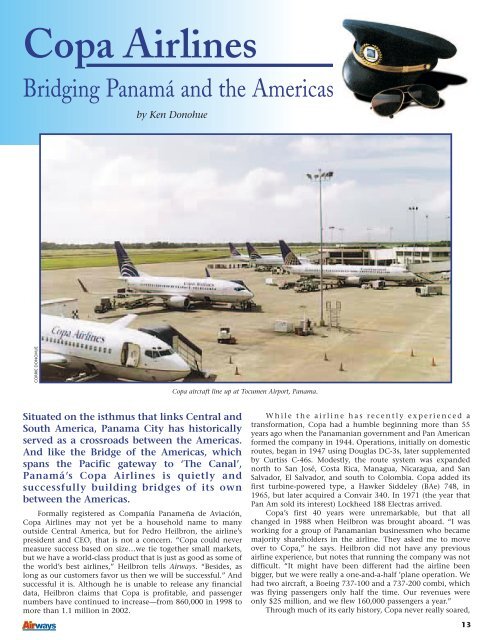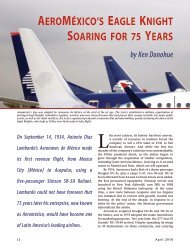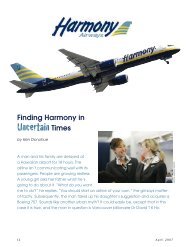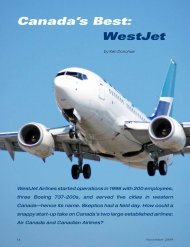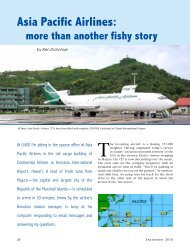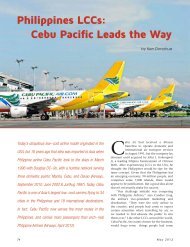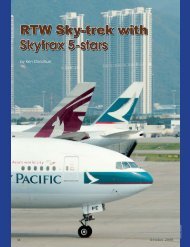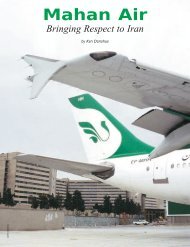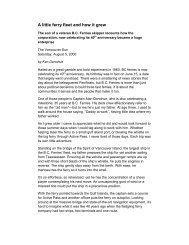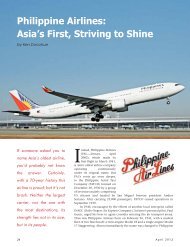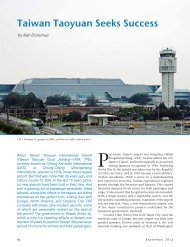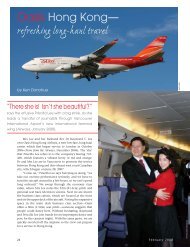Copa Airlines - Ken Donohue
Copa Airlines - Ken Donohue
Copa Airlines - Ken Donohue
Create successful ePaper yourself
Turn your PDF publications into a flip-book with our unique Google optimized e-Paper software.
<strong>Copa</strong> <strong>Airlines</strong><br />
Bridging Panamá and the Americas<br />
by <strong>Ken</strong> <strong>Donohue</strong><br />
CORRIE DONOHUE<br />
<strong>Copa</strong> aircraft line up at Tocumen Airport, Panama.<br />
Situated on the isthmus that links Central and<br />
South America, Panama City has historically<br />
served as a crossroads between the Americas.<br />
And like the Bridge of the Americas, which<br />
spans the Pacific gateway to ‘The Canal’,<br />
Panamá’s <strong>Copa</strong> <strong>Airlines</strong> is quietly and<br />
successfully building bridges of its own<br />
between the Americas.<br />
Formally registered as Compañía Panameña de Aviación,<br />
<strong>Copa</strong> <strong>Airlines</strong> may not yet be a household name to many<br />
outside Central America, but for Pedro Heilbron, the airline’s<br />
president and CEO, that is not a concern. “<strong>Copa</strong> could never<br />
measure success based on size…we tie together small markets,<br />
but we have a world-class product that is just as good as some of<br />
the world’s best airlines,” Heilbron tells Airways. “Besides, as<br />
long as our customers favor us then we will be successful.” And<br />
successful it is. Although he is unable to release any financial<br />
data, Heilbron claims that <strong>Copa</strong> is profitable, and passenger<br />
numbers have continued to increase—from 860,000 in 1998 to<br />
more than 1.1 million in 2002.<br />
While the airline has recently experienced a<br />
transformation, <strong>Copa</strong> had a humble beginning more than 55<br />
years ago when the Panamanian government and Pan American<br />
formed the company in 1944. Operations, initially on domestic<br />
routes, began in 1947 using Douglas DC-3s, later supplemented<br />
by Curtiss C-46s. Modestly, the route system was expanded<br />
north to San José, Costa Rica, Managua, Nicaragua, and San<br />
Salvador, El Salvador, and south to Colombia. <strong>Copa</strong> added its<br />
first turbine-powered type, a Hawker Siddeley (BAe) 748, in<br />
1965, but later acquired a Convair 340. In 1971 (the year that<br />
Pan Am sold its interest) Lockheed 188 Electras arrived.<br />
<strong>Copa</strong>’s first 40 years were unremarkable, but that all<br />
changed in 1988 when Heilbron was brought aboard. “I was<br />
working for a group of Panamanian businessmen who became<br />
majority shareholders in the airline. They asked me to move<br />
over to <strong>Copa</strong>,” he says. Heilbron did not have any previous<br />
airline experience, but notes that running the company was not<br />
difficult. “It might have been different had the airline been<br />
bigger, but we were really a one-and-a-half ’plane operation. We<br />
had two aircraft, a Boeing 737-100 and a 737-200 combi, which<br />
was flying passengers only half the time. Our revenues were<br />
only $25 million, and we flew 160,000 passengers a year.”<br />
Through much of its early history, <strong>Copa</strong> never really soared,<br />
13
ut instead maintained a level flight<br />
path, barely making it onto the industry’s<br />
radar screen. “I wouldn’t say the airline<br />
was mismanaged, as much as it was<br />
managed without a vision. No one paid<br />
much attention to it,” muses Heilbron.<br />
When he took control of the airline,<br />
shareholders did not have any specific<br />
ideas or goals, but believed that if the<br />
company were better run it would<br />
flourish. The first thing Heilbron wanted<br />
to do was coordinate flights with rival<br />
Air Panamá Internacional (API), the<br />
government-owned flag carrier which, at<br />
the time, enjoyed a better reputation<br />
than <strong>Copa</strong>. “Our route network consisted<br />
mostly of Central America, while Air<br />
Panamá primarily served South America,<br />
but there were few flights between<br />
Central and South America,” remembers<br />
Heilbron. “So, I proposed that we<br />
coordinate flights and services, which<br />
would benefit both airlines.” But<br />
this idea never came to fruition. The<br />
government, a military dictatorship, felt<br />
that <strong>Copa</strong> was not supportive of its<br />
policies, so it ordered API not to<br />
cooperate. But a dark chapter in<br />
Panamá’s history was about to change<br />
the fortunes of both <strong>Copa</strong> and API.<br />
On December 20, 1989, the USA,<br />
under the auspices of Operation Just<br />
Cause, attacked Panama City with<br />
airborne and ground forces. The goal<br />
was to protect American lives, maintain<br />
the security of the Panama Canal,<br />
restore democracy to Panamá, and to<br />
capture General Manuel Noriega, the<br />
Panamanian leader, and bring him to<br />
justice. After taking refuge in the<br />
embassy of the Vatican for more than<br />
two weeks, Noriega finally gave himself<br />
up. He was flown to the US where he<br />
was convicted on eight counts of<br />
racketeering, drug trafficking, and money<br />
laundering, and sentenced to 40 years<br />
in prison.<br />
The new government, which had<br />
defeated Noriega in a previous election,<br />
quickly began selling all unproductive<br />
state-owned operations. As a result, API<br />
closed its doors after attempts to privatize<br />
the airline failed. “That decision<br />
obviously helped us,” admits Heilbron,<br />
“but there wasn’t room for two airlines in<br />
Panamá anyway.” Heilbron further states<br />
that governments are not efficient<br />
managers of airlines, and argues that it<br />
was not only good for <strong>Copa</strong>, but also<br />
good for Panamá. Thus, in the early<br />
Nineties, <strong>Copa</strong> busied itself on creating a<br />
successful hub and an airline that<br />
Panamanians could be proud of. Today,<br />
<strong>Copa</strong>’s ‘Hub of the Americas’ at<br />
Aeropuerto General Omar Torrijos<br />
Herrera, commonly known as Aeropuerto<br />
Internacional de Tocumén—Panamá’s<br />
Types used by COPA during its first four decades include the Douglas DC-3, HS 748,<br />
and Lockheed Electra.<br />
international airport—is a large part of its success. “Central American airlines were<br />
busy competing with US airlines on routes to the USA,” notes Heilbron. “<strong>Copa</strong> had the<br />
luxury of not being in the American market, so we focused instead on an intra-Latin<br />
American network.”<br />
During the mid-Nineties, expansion at <strong>Copa</strong> accelerated as the airline received<br />
some destinations and routes that had previously belonged to API. These included<br />
Quito, Guayaquil, Bogotá, Lima, and Caracas. Between 1992 and 1998, <strong>Copa</strong> had a<br />
commercial agreement with the Central American Grupo TACA (Transportes Aéreos<br />
Centro Americanos) conglomerate, but the most significant development in the<br />
airline’s history came in 1998 when the airline signed a comprehensive accord with<br />
Continental <strong>Airlines</strong>. Implemented in May 1999, the deal saw Continental acquire a<br />
PHOTOS: FRANZ MANFREDI<br />
14 April 2003
FRANZ MANFREDI<br />
COPA Captain Toti Rios with two flight attendants at the old<br />
Tocumén Airport.<br />
49% stake in the Panamanian airline, and <strong>Copa</strong>’s image was<br />
changed to better reflect its new partner. New aircraft were<br />
purchased, and as these were options that Continental held,<br />
the configurations were the same. Continental personnel<br />
came to Panamá, and <strong>Copa</strong> adopted the larger airline’s<br />
maintenance procedures, passenger handling procedures,<br />
and Computer Reservations System (CRS). <strong>Copa</strong>’s board of<br />
directors now consists of four Panamanians and three from<br />
Continental <strong>Airlines</strong>.<br />
Heilbron bristles at the notion that this agreement may<br />
be seen as limiting <strong>Copa</strong>’s independence. “Countries worry<br />
more about independence…we are in the business of being<br />
successful,” he stresses. Heilbron does admit that in some cases<br />
the deal with Continental might restrict <strong>Copa</strong>, although he<br />
believes that in the end it will make it better. “The airline<br />
business is all about networks, and with the agreement, <strong>Copa</strong><br />
has a much larger market,” explains Heilbron. “We can offer<br />
more than any other Latin American carrier, and let’s not forget,<br />
Continental’s network to Central and South America has<br />
increased.” Panamá is geographically in the best location,<br />
Heilbron points out. “That is definitely one of our strengths. We<br />
also have brand-new aircraft, which along with our efficient hub<br />
at Tocumén, has led to an enviable on-time performance record<br />
of more than 90 percent.” When told that our flight from<br />
Havana, the previous day, was 40 minutes late, Heilbron smiles.<br />
“I didn’t say we were 100 percent. “Yesterday was a terrible day<br />
for on-time performance, yet we still finished the day at 75<br />
percent.” Indeed, <strong>Copa</strong>’s on-time performance is a source of<br />
great pride for the airline’s 2,300 employees. In 2002, <strong>Copa</strong> had<br />
some 15 days of perfect on-time performance. (On our return<br />
flight, we arrived at the gate 30 minutes before departure and<br />
found most of the passengers already on board. We pushed back<br />
five minutes before schedule.)<br />
Heilbron does not credit one thing or individual with<br />
<strong>Copa</strong>’s achievements. “We have the right people, with the right<br />
focus…everyone is clear on what we need to do be a successful<br />
airline.” He also quickly notes that many of the airline’s<br />
weaknesses were solved with the Continental allianceæ<br />
economies of scale, networks, and shared technical expertise<br />
and knowledge.<br />
While the airline is pleased with its performance, there are<br />
two immediate concerns that it must address: Tocumén and<br />
route rights. According to Heilbron, the airport needs to<br />
modernize and expand to keep pace with <strong>Copa</strong>’s future plans.<br />
“In terms of gates and aircraft access to the terminal, we are<br />
already at capacity.” The need for an open skies agreement<br />
within Latin America is another challenge. “Panamá has been<br />
successful at negotiating some open skies agreements,” says<br />
Heilbron, “But the lack of a region-wide agreement really holds<br />
back growth; not just for <strong>Copa</strong>, but for other airlines, as well.”<br />
Heilbron thinks a Latin American open skies agreement would<br />
be good for airlines and good for customers, but comments that<br />
often governments forget about the customers.<br />
The immediate priority for <strong>Copa</strong> is to increase frequencies<br />
in currently served markets. To do this, the airline is busy taking<br />
COPA received its first Boeing 737 (a -100) in 1980. This is one of its Dash 200s.<br />
GARY JENNINGS<br />
15
delivery of new aircraft. At the end of 2002, the<br />
airline had 20 aircraft in its fleet, comprising 12<br />
Boeing 737-700s and eight 737-200s. <strong>Copa</strong> also<br />
has six firm orders and six options for 737NGs,<br />
with the first two deliveries of 2003 scheduled to<br />
be 737-800s. The Dash 200s will be phased out<br />
by 2005.<br />
Like spokes radiating from the center of<br />
a bicycle wheel, <strong>Copa</strong> currently serves 27<br />
destinations in 19 countries. From Los Angeles<br />
to Buenos Aires, the airline flies throughout the<br />
Americas and the Caribbean. <strong>Copa</strong>’s route<br />
network is as varied as the cities it serves. From<br />
short hops to Costa Rica and Colombia, to some<br />
of the longest scheduled 737 services in the<br />
worldæ Panamá to Buenos Aires (a sector time of<br />
just over seven hours), São Paulo, Santiago, and<br />
Los Angeles.<br />
Because of its long routes, coupled with<br />
‘hot-and-high’ airports, <strong>Copa</strong> was the second<br />
airline in the world, after <strong>Ken</strong>ya Airways, to<br />
install Aviation Partners Boeing blended<br />
winglets on its 737-700s. The winglet-equipped<br />
aircraft are more fuel-efficient, carry a bigger<br />
payload, and have reduced engine maintenance<br />
costs (Airways, April 2001). “We have been very<br />
satisfied with the winglets,” says Heilbron. “It<br />
makes sense for the routes we serve. We’ve seen<br />
a four percent improvement on fuel burn, and<br />
we are in the process of retrofitting previous<br />
deliveries of the 700 with the winglets.” While<br />
winglets are factory options for the 737-800,<br />
Boeing will not install them on the -700s,<br />
so <strong>Copa</strong> sends its aircraft to Cascade Aerospace<br />
in Abbotsford, British Columbia, for the<br />
modification.<br />
<strong>Copa</strong> <strong>Airlines</strong> has a diverse workforce. Ten<br />
percent of the company’s pilots are Latin<br />
American expatriates and, ironically under a<br />
protectionist piece of Panamanian legislation,<br />
they must all be captains. The airline also has<br />
some expat executives. “It’s difficult for small<br />
countries to have local talent,” remarks<br />
Heilbron. “Besides, aviation is a global<br />
business…we compete against the best airlines<br />
in the world, so we must recruit the best people<br />
to work for us.”<br />
Captain Larry Ganse, <strong>Copa</strong>’s vice president<br />
of operations, is a good example. Ganse, who<br />
spent 27 years with TWA, and subsequently time<br />
with Northwest <strong>Airlines</strong> and Grupo TACA before<br />
<strong>Copa</strong>, is currently qualified on the 737-700, and<br />
usually flies a scheduled route three times a<br />
month. He says that leaving the office for the<br />
flightdeck is his reality check. Generally, expats<br />
are graciously accepted at <strong>Copa</strong>. “Panamá is a<br />
very cosmopolitan place, and is amazingly<br />
tolerant,” he enthuses.<br />
The slump in the global airline industry,<br />
following the events of September 11, 2001, did<br />
not affect <strong>Copa</strong> as much as it did others. “We<br />
have done well despite the downturn,” asserts<br />
Heilbron, as he knocks on a wooden table. “It<br />
really only affected us for a few months. The US<br />
routes are still slow, but they account for only 25<br />
percent of our market share. Other routes have<br />
returned to normal.” Heilbron adds that Latin<br />
Los Angeles<br />
Mexico City<br />
Houston<br />
Cancún<br />
Newark<br />
Orlando<br />
Miami<br />
Havana<br />
Montego<br />
Bay<br />
Guatemala<br />
Managua<br />
San Salvador<br />
San Jose<br />
Panama<br />
Lima<br />
Port-au-<br />
Prince Santo Domingo<br />
Kingston<br />
San Juan<br />
Barranquilla<br />
Cartagena Caracas<br />
Medellin<br />
Bogotá<br />
Cali<br />
Santiago<br />
Buenos Aires<br />
São Paulo<br />
<strong>Copa</strong> <strong>Airlines</strong> operates four of the longest-scheduled 737 routes in the world, from Panama<br />
City to Buenos Aires, Santiago, São Paulo, and Los Angeles.<br />
America is very diverse, pointing out that last year South America was strong<br />
and Central America was weak. This year, it is the opposite. “The countries of<br />
Latin America are never doing well at the same time,” he observes, “but that<br />
also means that they are never doing poorly at the same time.” And while many<br />
airlines were scrambling to implement tougher security measures, <strong>Copa</strong>, as with<br />
most Latin American airlines, was already spending more on security, because<br />
of its proximity to the drug trade. The airline was also quick to install steel<br />
reinforced cockpit doors on all its aircraft in the latter part of 2001.<br />
Nevertheless, it has not been all smooth flying for <strong>Copa</strong> <strong>Airlines</strong>. In March<br />
2001, the FAA downgraded Panamá’s rating in its International Aviation Safety<br />
Assessment program to Category 2, or failure to comply with ICAO<br />
(International Civil Aviation Organization) standards. The ruling limits US<br />
carriers from code-sharing with a Panamanian airline. Hence, Continental’s<br />
codes have been removed from <strong>Copa</strong>’s flights. “This has definitely affected us,”<br />
concedes Heilbron. “Revenues are being lost.” Heilbron says that the<br />
Panamanian government is working hard and making progress to restore the<br />
country to Category 1 status. “I support the FAA’s decision. The assessment<br />
was correct, but it is unfair to penalize airlines for what really should be a<br />
government issue.”<br />
<strong>Copa</strong> has witnessed many changes over the past three years, but its<br />
operational performance is especially noteworthy. In 2000, the airline’s on-time<br />
performance was 65%, and schedule completion was around 96%. Today, those<br />
figures are above 90% and 99%, respectively. “I was hired to try and fix this,”<br />
admits Capt Larry Ganse, with a sense of pride. “The biggest problem was the<br />
Quito<br />
ILLUSTRATION BY GREG SMITH<br />
16 April 2003
lack of a proper schedule. There was no systematic tracking and<br />
validation of block times.” Ganse also notes that the schedules<br />
were adjusted to realistically accommodate air traffic control in<br />
Panamá. “There is no doubt that the Continental connection<br />
has helped,” Ganse says, “Tom Chappelle, who is on loan from<br />
Continental, has done miracles with the airline’s logistics and<br />
spare parts provisioning, which contributes to a much higher<br />
dispatch reliability on the maintenance side.”<br />
Ganse observes that <strong>Copa</strong> is developing a new attitude.<br />
“There is something called la hora Panamania [Panamanian<br />
time]. “People thought that it was okay to show up for a 12<br />
o’clock meeting at 1215 or 1230…we’ve had to work to change<br />
that, but it’s been easier to do than I thought.” <strong>Copa</strong> now has an<br />
employee who is responsible for internal communications,<br />
and Ganse points out the bulletin boards that have been<br />
placed liberally through work areas that reinforce the airline’s<br />
positive results.<br />
As most in the airline industry will attest, no two days are<br />
alike. While Ganse shows us <strong>Copa</strong>’s operations center, he is<br />
briefed on the effects of El Reventador, the volcano that is<br />
erupting near Quito, Ecuador. Ash has caused minor damage to<br />
a 737 en route to Buenos Aires. Like a<br />
father concerned for an ill child, Ganse<br />
asks when the maintenance team will<br />
arrive in the Argentine capital. In the<br />
pilot’s briefing room, someone analyzes a<br />
large map that is hanging on the wall.<br />
One coloured line shows the usual flight<br />
path for aircraft flying between Panamá<br />
and Lima, Perú. Another shows the flight<br />
deviation to avoid the volcano. Ganse<br />
explains that the deviation will add<br />
about 20 minutes to the flight time, but<br />
he expresses confidence that the Lima<br />
station will be able to turn the aircraft<br />
around on schedule.<br />
Fundamentally, <strong>Copa</strong> is committed<br />
and focused on passenger traffic, but its<br />
revenues are supplemented by a modest<br />
operation at Tocumén Cargo Terminal, a<br />
wholly owned subsidiary, which <strong>Copa</strong><br />
established to manage its freight<br />
business. The aim is to take advantage of<br />
other airlines’ traffic, and the highsecurity<br />
installation handles cargo for FedEx, Iberia, and<br />
Continental. <strong>Copa</strong> also has an agreement with Aerosucre<br />
Colombia to wet-lease, for 150 hours a month, one<br />
of its former 737-200Cs.<br />
<strong>Copa</strong>’s maintenance hangar can accommodate<br />
two Boeing 737s—well, sort of. The airline is<br />
working with the airport to extend the building,<br />
which would ensure that if two aircraft were in the<br />
hangar, both would be covered. At present, the tail<br />
of one aircraft juts out. The airline performs A<br />
checks at Panamá, while C checks on the -200s are<br />
conducted by Varig, at Pôrto Alegre in Brazil.<br />
<strong>Copa</strong> still has to decide where the C checks on its<br />
-700s will be performed, when they become due<br />
in 2004.<br />
Meanwhile, <strong>Copa</strong> is committed to increasing<br />
the skills of its employees, and Panamanians in<br />
general. To this end, the airline is working with<br />
the Universidad Tecnológica de Panamá to<br />
develop degree programs in engineering and<br />
transport studies. “Our continued success<br />
depends on training local talent,” explains<br />
Ganse. Technical English courses have been<br />
PHOTOS: CORRIE DONOHUE<br />
offered to the airline’s maintenance staff.<br />
Part of <strong>Copa</strong>’s success lies in its ability to be resourceful.<br />
Whether it is trying to secure unused buildings from the airport,<br />
or constructing its own simulators, the airline finds creative<br />
approaches to its operations. “We got our cockpit procedures<br />
training simulator from Continental, and then built the<br />
passenger cabin ourselves,” says Ganse. “We could have easily<br />
spent more than a million dollars on a brand new one, but this<br />
one only cost us about $20,000. It might not have all the bells<br />
and smoke, but it gives the pilots, and cabin crew, a fairly<br />
realistic environment to work in.”<br />
On the hangar floor, as we walk under one of the airline’s<br />
737s, Ganse points to the red tape that covers every possible<br />
opening which might be a place to hide contraband. “So far we<br />
haven’t had a problem with drugs being found on our aircraft,”<br />
he reveals, “but it is something we take very seriously.” As the<br />
first of the two 737s is pushed out of the hangar, Ganse is<br />
assured by the maintenance supervisor that both aircraft will be<br />
flying that evening.<br />
Tocumén has two satellites, one equipped with seven<br />
airbridges and the other with six. The main terminal, which<br />
<strong>Copa</strong>’s maintenance hanger.<br />
Friendly staff man <strong>Copa</strong>’s check-in counter.<br />
17
Aerial view of Tocumen<br />
Airport and (above) the main<br />
terminal building.<br />
connects the two satellites, has space for four aircraft, two of<br />
them on remote stands. The hub is a source of great pride for<br />
<strong>Copa</strong>. “We have created such an efficient operation, which is a<br />
big part of our success,” comments Ganse. “Most of our traffic is<br />
connecting, so we have a maximum connect time of an hour,<br />
and a minimum connect time of 30 minutes. <strong>Copa</strong> contracts its<br />
catering to LSG Sky Chefs (Airways, June 1998). But it operates<br />
its own catering trucks, which Ganse says is more efficient and<br />
saves money. Tocumén has some advantages, being one of the<br />
few airports in Latin America that has two parallel runways,<br />
which can easily handle increased traffic. And it enjoys great<br />
weatheræit is closed for less than an hour each year.<br />
During the airline’s two peak periodsæDecember/January<br />
and July/August—college students are hired to help direct and<br />
move connecting passengers. The students wear bright red<br />
T-shirts, and are paid a small wage and given a free ticket on<br />
<strong>Copa</strong>’s system. This program has been a big success and, unlike<br />
in some parts of the world, the airline’s unions so far have<br />
not objected.<br />
Ganse often comes to the airport’s President’s Club Lounge,<br />
<strong>Copa</strong> <strong>Airlines</strong> now has one of the youngest fleets in Latin America and is the largest Boeing 737NG in the region.<br />
18 April 2003<br />
PHOTOS:THOMAS D MAYES Jr
Fast Facts<br />
<strong>Copa</strong> <strong>Airlines</strong><br />
(Compañía Panameña de Aviación)<br />
IATA: CM ICAO: CMP IATA/ARC: 230 RADIO: <strong>Copa</strong><br />
Ave Justo Arosemena y Calle 39 Tel: +507 227 2522<br />
Apartado, Postal 1572 Fax: +507 227 1952<br />
Panamá 1,<br />
Res:1 800 359 2672 (US)<br />
Panamá PR: +1 507 227 0116<br />
Email: cserv@mail.copa.com.pa<br />
Website: www.copaair.com<br />
Cities served: Central America: Guatemala City, San Salvador, Managua,<br />
San José, Panama City North America: Cancún, Los Angeles, Mexico City,<br />
Miami, Orlando Caribbean: La Habana [Havana], Kingston, Puerto Principe,<br />
San Juan, Santo Domingo South America: Barranquilla, Bogotá, Buenos<br />
Aires, Cali, Caracas, Cartagena, Guayaquil, Lima, Medellín, Quito, Santiago,<br />
São Paulo<br />
FFP:Continental OnePass<br />
Traffic: (estimated 2002) Passengers: 1.1 million<br />
THOMAS D MAYES Jr GIANFRANCO BETING<br />
where he proudly oversees the airport’s operations. Staff<br />
affectionately refer to one area as ‘Larry’s Office’, but on this<br />
night someone is sitting in his favorite spot. As the dark of<br />
evening settles over Panamá, the lights of incoming aircraft can<br />
be seen in the distance, lining up for final approach. As a <strong>Copa</strong><br />
<strong>Airlines</strong> 737 touches down, Ganse says with pride, “<strong>Copa</strong> is a<br />
good airline, but we have all the pieces to be a great airline.”<br />
Founded:August 30, 1944<br />
Start date:May 5, 1947<br />
Chairman: Alberto C Motta<br />
CEO: Pedro Heilbron<br />
Employees: 2,300<br />
Ownership: Motta Internacional (51%), Continental <strong>Airlines</strong> (49%)<br />
Fleet<br />
Type No Seats Engines<br />
Boeing 737-200 8 C8Y106 PW JT8D-15<br />
Boeing 737-700 12 C12Y112 CFM56-7B24<br />
On order<br />
737-700 4 (+4 options)<br />
2 (+2 options) (C14Y141)<br />
delivery from October 2003<br />
19


